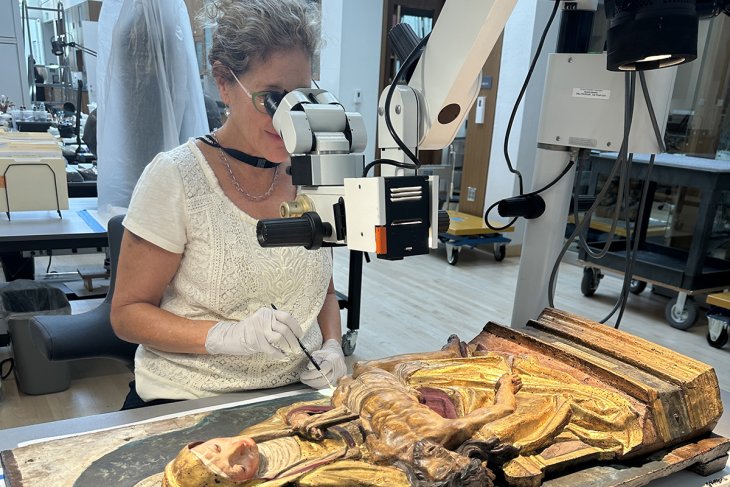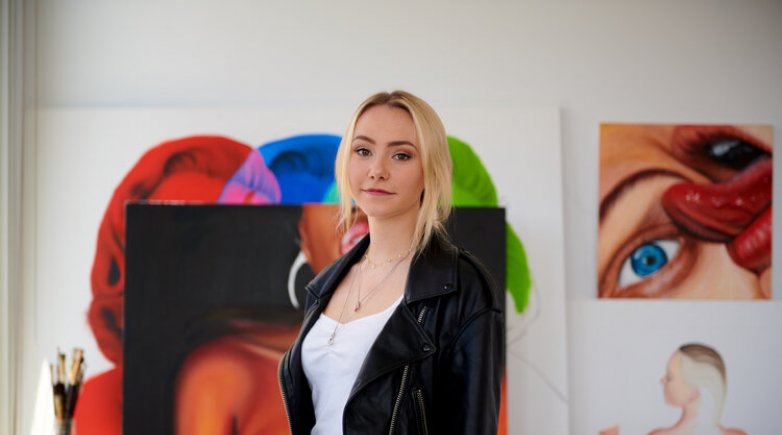Monica DiLisio Berry

“You’re looking at a ceramic that’s 2,500 years old, and you see fingerprints in the clay body. It feels spiritual.”
Although she might not use the term, Monica Berry ’83 is a healer. Her patients’ needs vary: Some may have a simple fracture, while others may be weakened from botched surgeries. Some are so frail from years of neglect, they require a house call. They range in age from newborn to around 4,500 years old. They are cultural artifacts — sculptures, decorative arts, archaeological materials, outdoor monuments and contemporary art.
For over 25 years as a freelance conservator, Berry has helped museums, historic properties, artists, galleries and private collectors preserve objects and sculptures. “I really like to be hands-on, to look at art up close,” she says. “What drew me to conservation was that it requires attentive looking, and I was actually given permission to touch! I think it’s a privilege to have your hands on something that has cultural significance."
Berry originally intended to become a healer of people. But while completing premedical requirements at Cornell, she was also studying Italian, majoring in art history and taking studio art classes. She found herself enraptured by the “new, bright colors” emerging from the 1980s Sistine Chapel restoration.
Forgoing medical school, she studied art conservation in Italy after graduation, then obtained a master’s degree in art history and diploma in conservation from The Conservation Center of the Institute of Fine Arts at New York University. Later, she obtained a diploma in art conservation from Harvard University Art Museums’ Straus Center for Conservation and Technical Studies. At the time, in the 1990s, NYU’s Conservation Center was one of only three programs in the country offering the requisite training in chemistry, art history and hand skills.
Over the years, Berry has cleaned coins at an excavation site on the Aegean island Samothrace, rehabilitated Amazonian featherwork at the National Museum of the American Indian in Washington, D.C., stabilized the experimental glazes of a contemporary sculptor, and laid hands on every artifact in the Greek and Roman gallery at the Muesum of Fine Arts in Boston.
“You’re looking at ceramic that’s, say, 2,500 years old, and you see fingerprints in the clay body,” she says. “It feels spiritual.”
For the past eight months Berry has been back at the MFA, immersed in Renaissance Venice as she works on an imposing 15th-century altarpiece by Bartolomeo Vivarini. Acquired by the museum in 1901, the ornately framed altarpiece features an approximately three-foot-high painted wooden pietà, surrounded by painted wooden panels of saints. Carved in high relief, the pietà centerpiece was clearly intended to leap from the flat background, but over centuries, it had darkened and deteriorated.
“There was a lot of detail that had been completely obscured,” Berry says. An earlier varnish application had yellowed, coating the sculpture with a murky residue. Christ’s eyes were indistinct under layers of grime, and years of devotional touching had eroded part of his foot. An earlier restoration effort had deformed Mary’s nose. Most worrisome from a structural standpoint were hundreds of tiny black holes pockmarking the sculpture, the result of pervasive damage from wood-boring worms. Well-meaning curators in the early 19th century had dipped the sculpture in hot beeswax to fill the holes, but the wax mostly stayed on the surface, where it attracted dirt.
Her patient, Berry says, “had a lot of problems.”
For this kind of polychrome wood piece, Berry says, the goal is “to let age be visible and not try to mask a lot, not try to do a lot of compensation.” Her mandate, therefore, was not to create a perfect replica, nor deceive viewers into thinking they were looking at an untouched original, but to illuminate the pietà’s essence through judicious, conservative care. As with an archaeological artifact: “You do want to see its age. You don’t want it to look perfect.”



